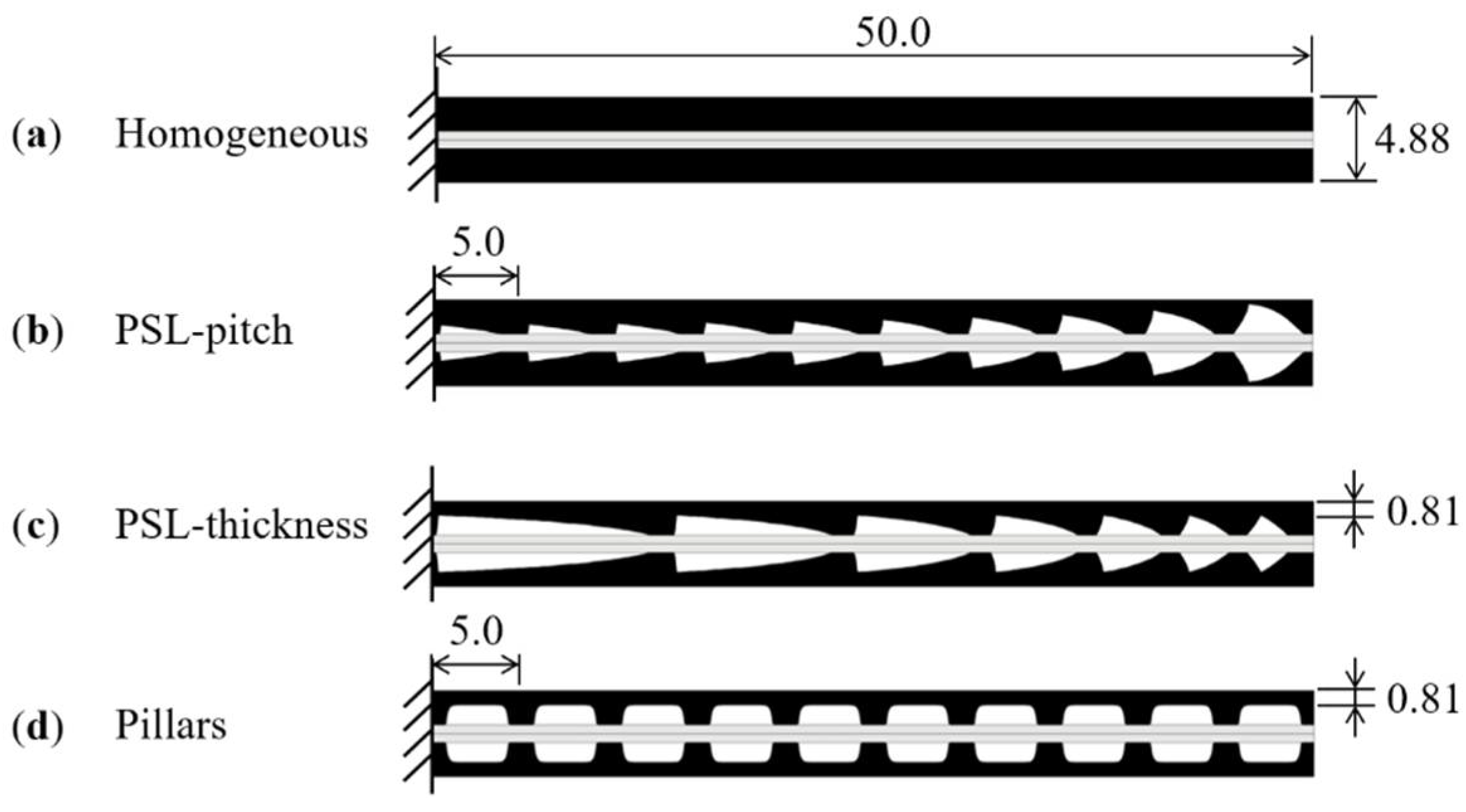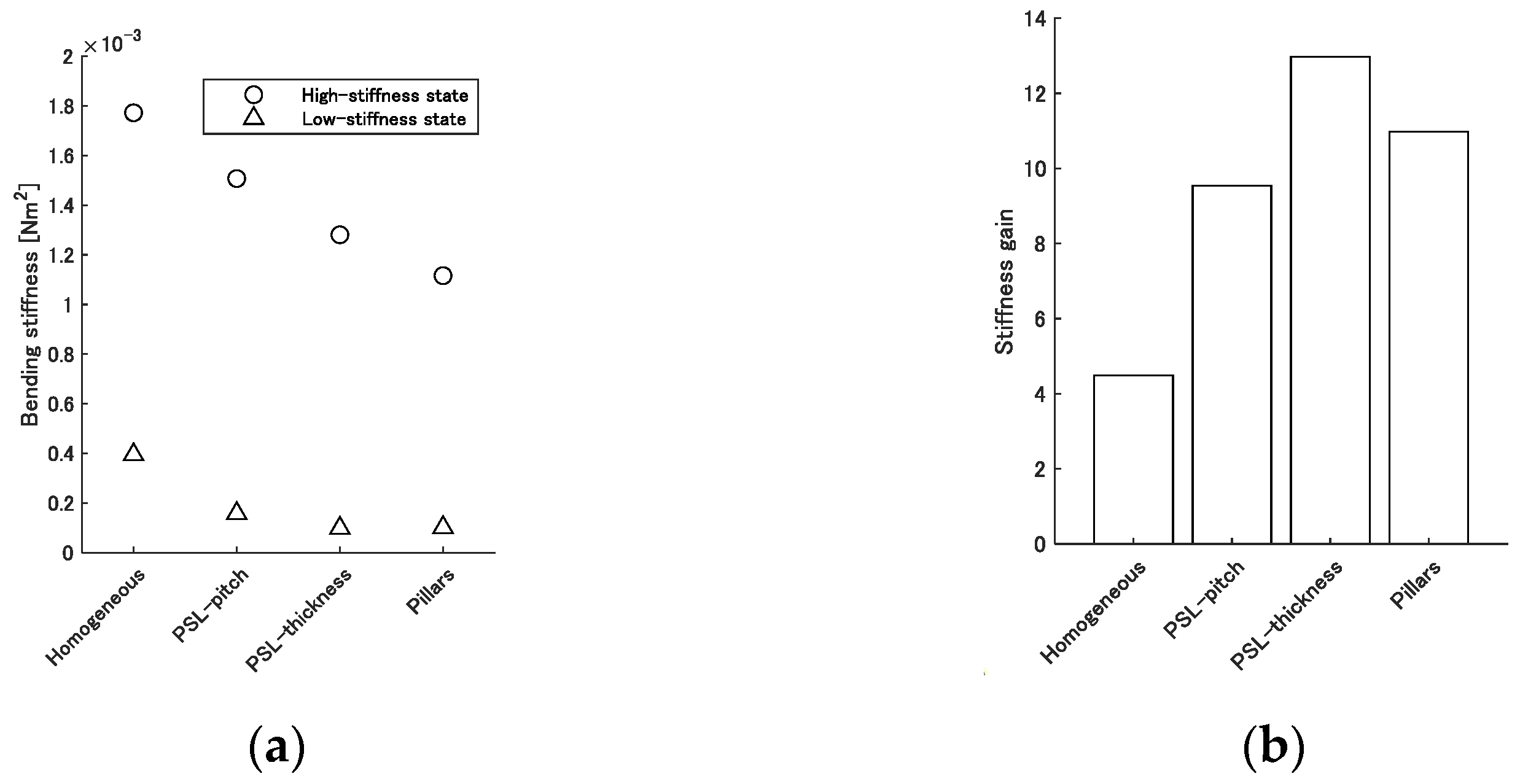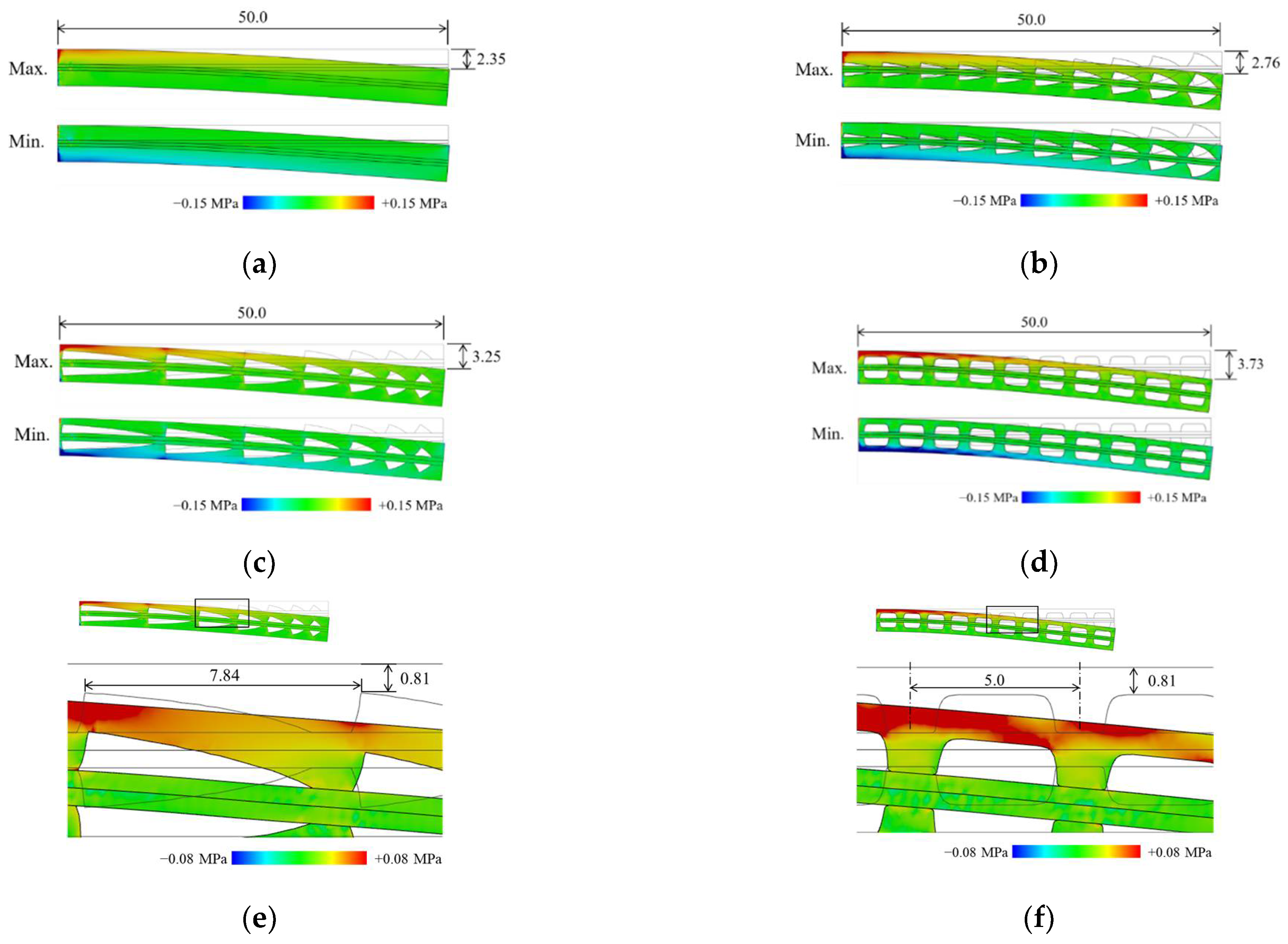Improvement of a Tunable Stiffness Organ-Grasping Device by Design of a Wavy-Shaped Beam Structure
Abstract
:1. Introduction
2. Methods
2.1. Mechanism of the Device
2.2. Improved Design of the Beams
3. FEM Study
3.1. Simulation Settings
3.2. Results
4. Discussion
5. Conclusions
Author Contributions
Funding
Institutional Review Board Statement
Informed Consent Statement
Data Availability Statement
Conflicts of Interest
References
- Osaki, M.; Omata, T.; Takayama, T.; Ohizumi, H. Transformable lung positioner for thoracoscopic surgery. In Proceedings of the 2011 IEEE/SICE International Symposium on System Integration (SII), Kyoto, Japan, 20–22 December 2011; pp. 138–143. [Google Scholar] [CrossRef]
- Gan, P. A novel liver retractor for reduced or single-port laparoscopic surgery. Surg. Endsc. 2014, 28, 331–335. [Google Scholar] [CrossRef]
- Kuwahara, K.; Tsukagoshi, H.; Kitagawa, A. A soft finger with the function of attaching and holding internal organs referring to an octopus sucker. In Proceedings of the JSME Conference Robotics and Mechatronics, Tsukuba, Japan, 22–25 May 2013. 1A1-B14. [Google Scholar] [CrossRef]
- Takayama, T.; Kuroda, K.; Omata, T. Suction hand for grasping large internal organs for laparoscopic surgery. In Proceedings of the JSME Conf. Robotics and Mechatronics, Toyama, Japan, 25–29 May 2014. 3P1-C02. [Google Scholar] [CrossRef]
- Cheng, N.; Ishigami, G.; Hawthorne, S.; Chen, H.; Hansen, M.; Telleria, M.; Playter, R.; Iagnemma, K. Design and analysis of a soft mobile robot composed of multiple thermally activated joints driven by a single actuator. In Proceedings of the 2010 IEEE International Conference Robot and Automation, Anchorage, AK, USA, 3–7 May 2010; pp. 5207–5212. [Google Scholar] [CrossRef]
- Zhang, Y.-F.; Zhang, N.; Hingorani, H.; Ding, N.; Wang, D.; Yuan, C.; Zhang, B.; Gu, G.; Ge, Q. Fast-Response, stiffness-tunable soft actuator by hybrid multimaterial 3D printing. Adv. Funct. Mater. 2019, 29, 1806698. [Google Scholar] [CrossRef]
- Yamanaka, N.; Matsumiya, K.; Masamune, K.; Dohi, T.; Yamashita, H.; Chiba, T.; Liao, H. Balloon-based manipulator with multiple linkages for intrauterine surgery. In Proceedings of the 2007 IEEE/RSJ International Conference Intelligent Robots System, San Diego, CA, USA, 29 October–2 November 2007; pp. 1278–1283. [Google Scholar] [CrossRef]
- Degani, A.; Choset, H.; Zubiate, B.; Ota, T.; Zenati, M. Highly articulated robotic probe for minimally invasive surgery. In Proceedings of the 2006 IEEE International Conference Robotics and Automation, Orlando, FL, USA, 15–19 May 2006; pp. 4167–4172. [Google Scholar] [CrossRef] [Green Version]
- Kim, Y.-J.; Cheng, S.; Kim, S.; Iagnemma, K. A stiffness-adjustable hyperredundant manipulator using a variable neutral-line mechanism for minimally invasive surgery. IEEE Trans. Robot. 2014, 30, 382–395. [Google Scholar] [CrossRef] [Green Version]
- Brown, E.; Rodenberg, N.; Amend, J.; Mozeika, A.; Steltz, E.; Zakin, M.R.; Lipson, H.; Jaeger, H.M. Universal robotic gripper based on the jamming of granular material. Proc. Natl. Acad. Sci. USA 2010, 107, 18809–18814. [Google Scholar] [CrossRef] [Green Version]
- Kim, Y.-J.; Cheng, S.; Kim, S.; Iagnemma, K. A novel layer jamming mechanism with tunable stiffness capability for minimally invasive surgery. IEEE Trans. Robot. 2013, 29, 1031–1042. [Google Scholar] [CrossRef]
- Kim, J.; Nakajima, Y.; Kobayashi, K. A suction-fixing, stiffness-tunable liver manipulator for laparoscopic surgeries. IEEE/ASME Trans. Mechatron. 2018, 23, 262–273. [Google Scholar] [CrossRef]
- Nakajima, Y.; Suzuki, R.; Suzuki, Y.; Sugino, T.; Kawase, T.; Onogi, S.; Seki, H.; Fujiwara, T.; Ouchi, K. Suction-fixing surgical device for assisting liver manipulation with laparoscopic forceps. Int. J. CARS 2020, 15, 1653–1664. [Google Scholar] [CrossRef] [PubMed]
- Michell, A.G.M. The limits of economy of material in frame-structures. Pholos. Mag. 1904, 6, 589–597. [Google Scholar] [CrossRef] [Green Version]
- Hegemier, G.A.; Prager, W. On Michell trusses. Int. J. Mech. Sci. 1969, 11, 209–215. [Google Scholar] [CrossRef]
- Li, Y.; Chen, Y. Beam structure optimization for additive manufacturing based on principal stress lines. In Proceedings of the Solid Freeform Fabrication Proceedings, Austion, TX, USA, 9–11 August 2010; pp. 666–678. [Google Scholar]
- Tam, K.-M.M.; Mueller, C.T. Additive manufacturing along principal stress lines. 3D Print. Addit. Manuf. 2017, 4, 63–81. [Google Scholar] [CrossRef]
- Tsavdaridis, K.D.; Kingman, J.J.; Toropov, V.V. Application of structural topology optimisation to perforated steel beams. Comput. Struct. 2015, 158, 108–123. [Google Scholar] [CrossRef] [Green Version]
- Stromberg, L.L.; Beghini, A.; Baker, W.F.; Paulino, G.H. Application of layout and topology optimization using pattern gradation for the conceptual design of buildings. Struct. Multidisc. Optim. 2011, 43, 165–180. [Google Scholar] [CrossRef] [Green Version]











Publisher’s Note: MDPI stays neutral with regard to jurisdictional claims in published maps and institutional affiliations. |
© 2021 by the authors. Licensee MDPI, Basel, Switzerland. This article is an open access article distributed under the terms and conditions of the Creative Commons Attribution (CC BY) license (https://creativecommons.org/licenses/by/4.0/).
Share and Cite
Kawase, T.; Sugino, T.; Onogi, S.; Kawashima, K.; Nakajima, Y. Improvement of a Tunable Stiffness Organ-Grasping Device by Design of a Wavy-Shaped Beam Structure. Appl. Sci. 2021, 11, 4581. https://doi.org/10.3390/app11104581
Kawase T, Sugino T, Onogi S, Kawashima K, Nakajima Y. Improvement of a Tunable Stiffness Organ-Grasping Device by Design of a Wavy-Shaped Beam Structure. Applied Sciences. 2021; 11(10):4581. https://doi.org/10.3390/app11104581
Chicago/Turabian StyleKawase, Toshihiro, Takaaki Sugino, Shinya Onogi, Kenji Kawashima, and Yoshikazu Nakajima. 2021. "Improvement of a Tunable Stiffness Organ-Grasping Device by Design of a Wavy-Shaped Beam Structure" Applied Sciences 11, no. 10: 4581. https://doi.org/10.3390/app11104581





